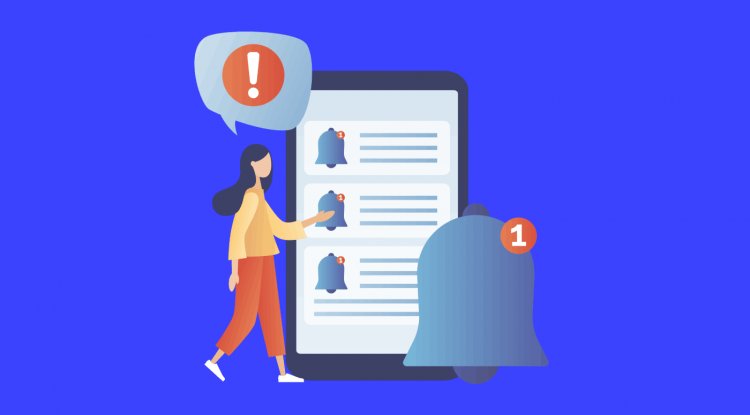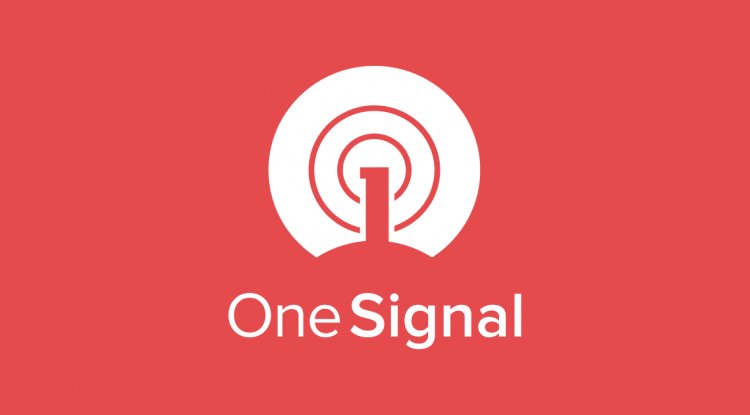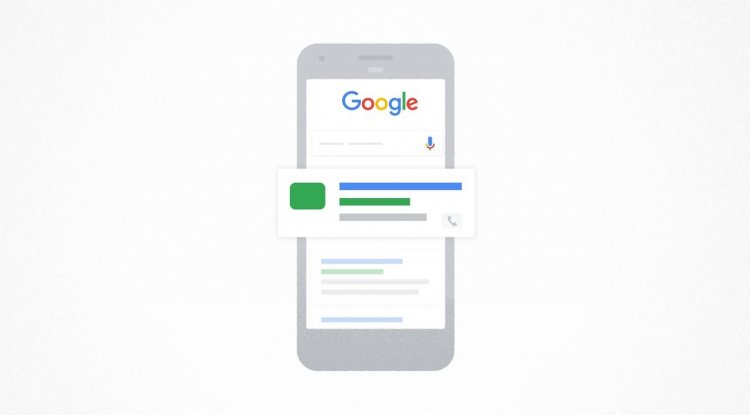Understanding Games that Retain
This blog was co-authored by Robbie Hopkins and Sarah Everitt.In an ever more crowded marketplace, it is an increasing challenge for mobile game developers to engage people and keep them coming back. To retain players, game developers have sharpened their focus on data, analytics, and detecting the signs of churn early in the player lifecycle, however this is not enough.It is much more effective to design for retention from the start, setting retention targets early in game development and using pre-launch and soft launch learnings. This article informs a comprehensive retention strategy to keep players engaged throughout gameplay and across the entire lifecycle.In 2021, Google Play partnered with The Behavioural Architects to explore how to optimize gameplay, deepen player loyalty, and drive long-term player retention. To learn from the best, we spoke to 15 leading game developers and 5 retention experts who shared their learnings and experience. This article summarizes our findings.


This blog was co-authored by Robbie Hopkins and Sarah Everitt.
In an ever more crowded marketplace, it is an increasing challenge for mobile game developers to engage people and keep them coming back. To retain players, game developers have sharpened their focus on data, analytics, and detecting the signs of churn early in the player lifecycle, however this is not enough.
It is much more effective to design for retention from the start, setting retention targets early in game development and using pre-launch and soft launch learnings. This article informs a comprehensive retention strategy to keep players engaged throughout gameplay and across the entire lifecycle.
In 2021, Google Play partnered with The Behavioural Architects to explore how to optimize gameplay, deepen player loyalty, and drive long-term player retention. To learn from the best, we spoke to 15 leading game developers and 5 retention experts who shared their learnings and experience. This article summarizes our findings. The full research report dives deeper into the detail, with more tactics and case studies to help build your retention strategy.

The developers we spoke to:
- Bake retention into their strategy from the start.
- Design with retention in mind, aligning internal targets, core mechanics, player gameplay, and more to drive engagement.
- Realize retention is a moving target. Improvements that move the needle today may not last, So their efforts to grow retention are constant, continually evolving, and span the player lifecycle.
We have distilled the best practices and insights from the developers and retention experts we spoke to into 9 key characteristics that can drive a successful retention strategy. These range from the basics, such as continual testing, to more sophisticated approaches to managing player progression and measuring the results.
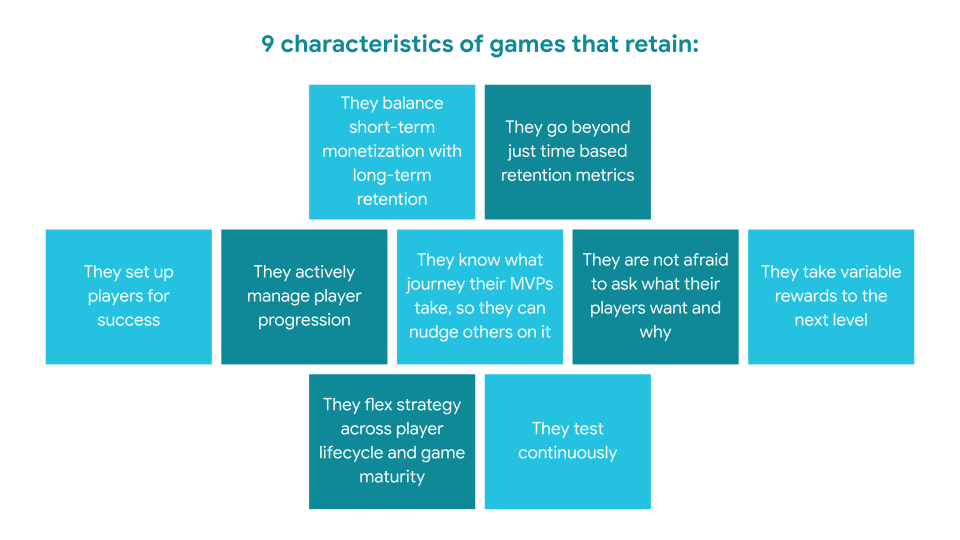
It is helpful to think of them as levels that you, like your players, progress through to reach a desirable goal — in this case, maximizing retention over the long term.
Level 1: Ahead of the game
Here the focus is on laying the groundwork for longer-term retention. Ensuring you set up the right targets to measure the impact of your retention efforts and LTV.
Balancing short- and long-term monetization
Achieving a positive balance between effective monetization and sustainable retention is essential. Finding this optimal balance of retention and monetization across a player’s lifecycle is challenging and can only be achieved by testing different scenarios.
For example, experimenting to find the right level of starting currency or assets to get players engaged early in the game and monetize them sustainably as they progress through later stages.
Profitable LTV is a good indicator that you have this balance right. While it can be a complex model to develop and implement, it is the most powerful tool for understanding game profitability. It can also be a useful lens to help optimize LiveOps, user acquisition, new features and content updates, and find the right balance of ad frequency.
Go beyond time-based metrics
To deliver an engaging user experience over time, draw on behavioral data about how people play the game. Use this behavioral data to define metrics and develop retention thresholds, the magical moments when players cross the line from merely interested to massively engaged.
Start by moving beyond time-based metrics (Day 1, Day 7, and so on) to define thresholds that help you understand and assess what makes a player loyal and valuable: levels completed, matches won, currency spent, or the number of social interactions a player makes. The retention thresholds will vary by game, but the goal is the same, to pick the right combination for your title that leads to meaningful retention.
Once you know the target to hit and behaviors to encourage, you can use them to define:
- Nudges and rewards to guide players towards these thresholds.
- Player cohorts and campaigns to acquire more of the same high-quality and highly engaged users.
You can then layer in deeper insights, such as player behavior in the context of specific features and mechanics, whether they are spenders, and how long they have been playing. Measuring retention at this deeper level can help you create gameplay and experiences that keep your players engaged and excited to see what is coming next.
Developer example:
Match Masters, a multiplier match-3 game where players can compete with friends, developed a suite of metrics that reflected the common actions and achievements completed across both the core game loop and additional systems. This included the number of levels reached, games completed, trophies unlocked, XP collected, and whether a player joined a team or invited a friend. The team analyzed each metric to establish the thresholds which correlated with higher retention. This allowed them to create compelling ways to migrate new players towards and across the retention thresholds by offering them free perks or gifts at each level.
Level 2: Getting into the game(play)
Here the focus is on motivating users and managing player progression in the game.
Setting players up to succeed
Ensuring players can succeed from the beginning helps turn interested users into dedicated fans. This starts from the first play session, where players need to feel a sense of accomplishment and anticipation. Give them an engaging reward straight away, and show them (visually) the milestones and features they can expect if they keep playing.
Manage player progression
Continue to manage the progression curve. Maintain the momentum by breaking big goals into smaller steps. Provide micro-rewards for smaller achievements, which also helps make reaching bigger goals feel more realistic and keeps players motivated.
Ensure, at all times, that wins and rewards are balanced with enough challenge — gameplay can’t be too easy or too hard. And it shouldn’t be too predictable. It is worth testing where the trade-off between player effort and reward lies for your title, especially for the first few sessions.
Players also need to feel they are growing with the game. Providing guidance and encouragement every step of the way helps ensure players accomplish what they set out to do. But it’s also essential to step back and give players a feeling they are in control of their experience.
Developer examples:
Head Ball 2, a multiplayer soccer game, used analytics to discover that if a player completed at least 8–10 matches on D1–3 they were more likely to be retained in the long-term. So they performed a number of interventions (e.g. boosters, free items or just allowing them to win) that ensured new players always reached the 8–10 match threshold.
Hill Climb Racing 2, an online multiplayer racing game, noticed a knowledge gap for some players, who did not tend to select the most appropriate vehicle for a track. They developed ‘soft nudges’ to guide players without undermining player autonomy. e.g. providing track profiles with features of vehicles that do well on that particular track.
Understanding your most valuable players, so you can nudge others along the way
MVPs (Most Valuable Players) are highly engaged and, hence, highly valuable. Put simply, MVPs show the highest level of retention and, by definition, deliver the highest LTV.
Knowing who they are and how they got there can pay dividends. It can help to analyze how they behave across the game lifecycle. For example, what actions they take, how many, and in what order, what features they interact with the most, and how long their sessions are. Then provide nudges by implementing the right mix of features, loops, and narratives to transform new cohorts into MVPs.
Ask players what they want
While analyzing data and research around what highly retained players want and need is useful, games that retain also go to the source and ask players directly. From focus groups to player polls and user surveys to ratings and reviews, knowing what users love and hate about your game is a must. This allows you to boost retention and build features that engage your MVPs and players like them.
Taking variable rewards to the next level
Evolving perks and rewards to keep players motivated and determined to progress can be challenging. Key to a successful reward strategy is making them relevant to your players and how they behave in your game.
Rewards should align with players’ in-game identity and actions. Players who appear stuck in their comfort zone might react positively to a bonus reward that reduces the risk of trying something new. Players who thrive on competition might respond to exclusive rewards that can only be won through mastery and accomplishment. Players who love to connect with their tribe might be retained longer with a social currency that shows they care.
And there are multiple parameters that can help keep rewards engaging: from varying the frequency, cadence, and value, to leaning into motivations like mastery, connectedness, and even the thrill of chasing the reward itself. Finally, deepening relevance by delivering something personal and exclusive to make players feel unique and special.
Developer examples:
Hills of Steel, a platform shooter game, built a reward calendar that worked as an appointment mechanic to keep players returning and excited to see the next reward. Rewards were laid out each day, getting progressively better as players built up a streak. On day 7, players unlocked a rare prize chest that had an unknown set of prizes.
PKXD, an adventure game, customizes rewards from mid-game onwards according to player motivations established from previous behavior. For example, they provide exclusive personalizations for players to become ‘more famous’ (e.g. unique armor). This creates new and unique rewards and further invests players in their character to build their identity and legend in the game.
Level 3: Make a game plan
Here the focus is on refining your strategy. Set out a holistic approach to your retention strategy along with tactics to continually test its effectiveness.
Flex strategy across player lifecycle and game maturity
It helps to map out a plan of retentive tactics to engage players across the lifecycle:
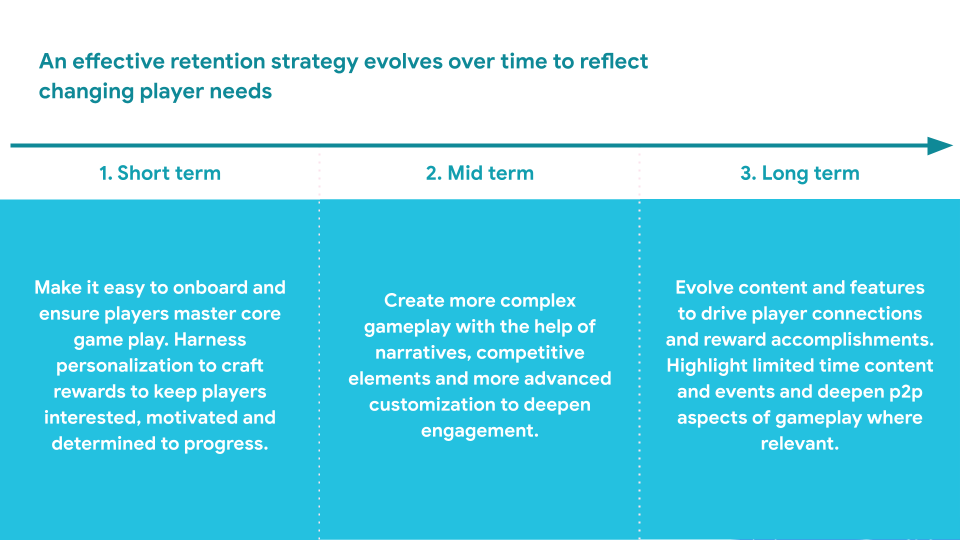
Test continually
Like all design, retention design is an iterative process. It requires creativity and a commitment to continual testing. It also demands patience to ensure the impact of testing can truly be measured, and the recognition that A/B testing isn’t the silver bullet solution to every question. Games that retain test, learn, and repeat the process to pinpoint changes and tweaks to boost players’ enjoyment and engagement with the game over time.
Also, remember that failure is a tool to learn what works and discard the rest. Being flexible and always ready to make corrections based on what you observe and measure will be richly rewarded.
In summary
Hopefully this article has been helpful in outlining what makes games that retain. Remember that it is never too late to implement the ideas and tactics discussed; there are always opportunities to impact and improve retention. Keep testing to find what works best for your title to increase the likelihood players will develop sustainable connections to the game.
To learn more about games that retain, check out the research report, with more tactics and case studies to help build your retention strategy.
Understanding Games that Retain was originally published in Google Play Apps & Games on Medium, where people are continuing the conversation by highlighting and responding to this story.
What's Your Reaction?

















